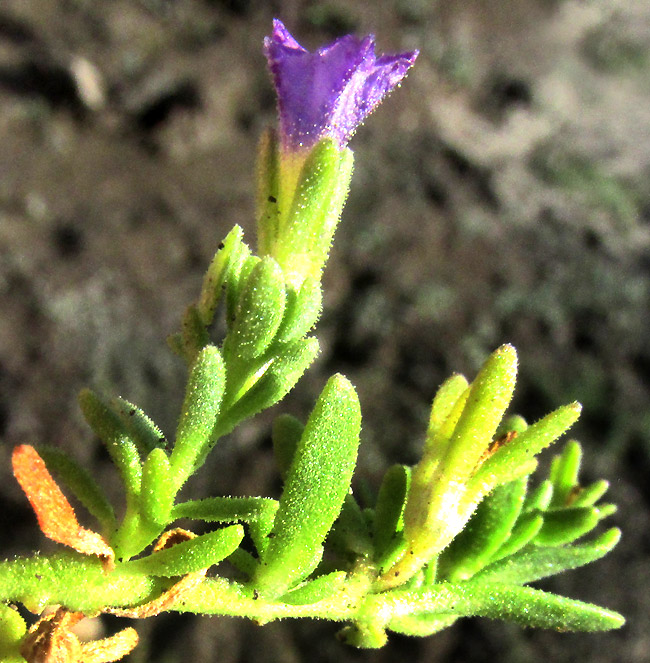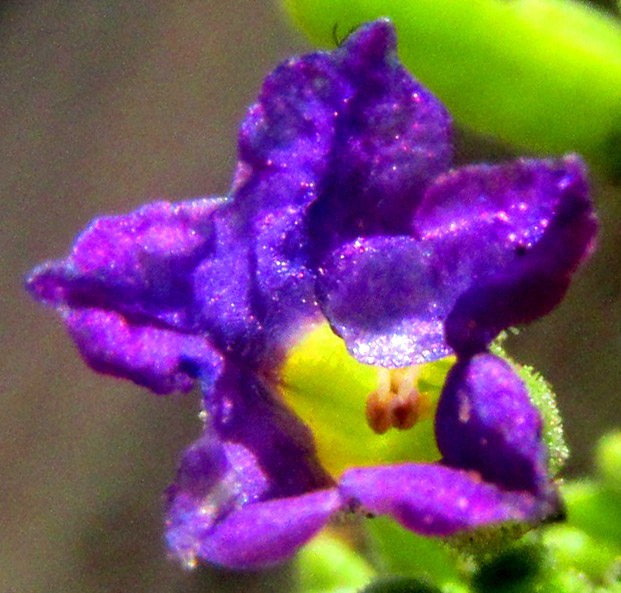Excerpts from Jim Conrad's
Naturalist Newsletter
Entry dated January 30, 2024, issued from near Tequisquiapan; elevation about 1,900m, (6200 ft), ~N20.57°, ~W99.89°; Querétaro state, MÉXICO
SEASIDE PETUNIA

The above kitchen-table-size plant formed a mat of small, branching stems radiating outward in all directions, in the bottom of the town's dried-up reservoir. Here we're experiencing what's normally the dry season, during a two-year period described by the North American Drought Monitor as a D3 Extreme Drought. The reservoir has been empty during most of these two years, from time to time acquiring only a shallow pond after modest rains mostly during what should have been the normal rainy season. Nowadays, usually the dark mud shown above is hard-baked and deeply cracked. Note that at the picture's bottom, white crystals of precipitated salts cover the drying mud. In short, the above plant is remarkable for being able to thrive in such a sometimes-submerged but recently mostly dried-out habitat -- also one regularly trampled by roving sheep looking for water and food.

In the plant's center, tiny flowers were just beginning to appear; the open ones are only about 5mm (3/16 inch) across. The plant with its simple, short, slender, fleshy leaves brings to mind certain stonecrops such as Sedum moranense. However, stonecrop flowers are larger and several stamens conspicuously extend beyond the corollas' throats.

Still, our reservoir plant's form, stems and leaves are reminiscent of stonecrop. However, similar fleshy, mat-forming plants like ours, through the process of convergent evolution, have arisen in numerous families of flowering plants. As Margaret Evans and others say in their 2014 study entitled "Insights on the Evolution of Plant Succulence from a Remarkable Radiation in Madagascar (Euphorbia)," "Succulent plants have evolved in response to arid conditions repeatedly, with various plant organs such as leaves, stems, and roots physically modified to increase water storage."
Consequently, even after seeing all the above, still I had no idea which plant family we might have here. Above, it's seen that the plant was densely covered with short hairs, the calyx produce five round-tipped sepals, and the corolla was funnel shaped with shallow lobes, but even these observations didn't help. Flowers would have to reveal the identity, but they were too tiny to examine properly with my handlens and old-man eyes.

The flower seen from above showed five corolla lobes, with one lobe confusingly turned sideways. The corolla was slightly asymmetric, the top lobes in the picture being larger than the lower ones. Within the corolla tube at least two stamens with brown anthers atop down-curving filaments were visible, though it was unclear whether more stamens were present. Snipping off the corolla's top for a better view provided this ambiguous view:

That's more surreally artful than technically revealing, but certain information was gained. First, the short hairs were topped with tiny, globular glands. Inside the corolla, the two previously seen anthers gathered on the right side of the knobby, pale stigma top. What was seen was suggestive of the Snapdragon or Figwort Family, the Scrophulariaceae. Species in that family often produce four stamens of which two are longer than the others, thus maybe appearing below our two visible ones. However, when I checked, no fleshy, mat-forming species like ours were found in that family.
On the Phylogenetic Tree of Life, a commonly occurring family positioned near the Figwort Family is the Nightshade/Potato/Tomato Family, the Solanaceae. When I looked there, I found our plant: it's CALIBRACHOA PARVIFLORA, in English usually known as the Seaside Petunia.
Calibrachoa parviflora flowers bear five stamens, of which two are longest, one is shortest, and the remaining two are positioned in between; we've only seen the longest two. The genus Calibrachoa currently is home to 29 accepted species, all of which are South American, except our Calibrachoa parviflora, which occurs in the southern US and most of Mexico, as well as in a separate population in the southern half of South America. One wonders about an ancient introduction of this species into North America and Mexico by indigenous people, or possibly migrating birds. The species also increasingly turns up as an invasive here and there worldwide in warm areas.
The Seaside Petunia is described as inhabiting ocean beaches and other sparsely vegetated soils with a high salt content, irrigated fields, and muddy areas. Plants are short-lived and ours appeared to be fast growing, and to branch prolifically as they grew. The 2019 study by Gerlado Mäder and Loreta Freitas entitled "Biogeographical, ecological, and phylogenetic analyses clarifying the evolutionary history of Calibrachoa in South American grasslands," informs us that the genus Calibrachoa arose fairly recently, only about four million years ago during the Pliocene Epoch.
At that time, while the global climate was changing from warmer than now to cooler, species of Calibrachoa evolved fast, first when ancestral species fractured into isolated populations, which evolved into new local species, and then, especially during the Pleistocene, or Ice Age, by ecological specialization due to ecological gradients within the resulting isolated populations. Our Seaside Petunia appears to have been one of the most successful at quickly evolving favorable adaptations, shedding light on its ability to flourish in such unpredictable environments as our dried-up municipal reservoir.
The 2013 study by Natalia Vercelli and others entitled "Plantas medicinales de los bajos alcalinos de la cuenca del arroyo del Azul (provincia de Buenos Aires, Argentina)," reports that in the alkali flats along Argentina's Arroyo del Azul, a creek in Buenos Aires province, Calibrachoa parviflora is used as a narcotic. That's not surprising, since it belongs to the same family as Tobacco.
By the way, our plant's petunia name comes honestly; it is very closely related to regular garden petunias, earlier even being assigned to the genus Petunia.